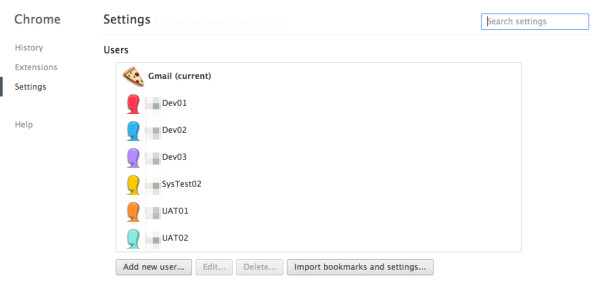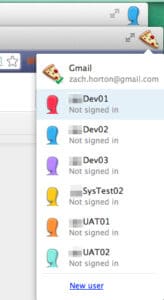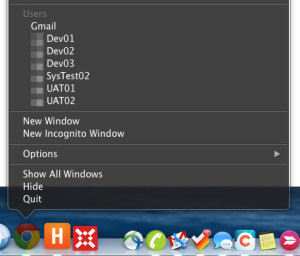In my never ending quest to improve efficiency, the challenge of working in multiple sandboxes for multiple clients has been an area where I’ve seen need for improvement. I’ve written previously about how to use Fluid in order to create separate isolated “Applications” for each Salesforce org you frequently work with. After using Fluid for a few months, its shortcomings started becoming more apparent to me. I wasn’t able to add extensions to Fluid which bummed me out because I was really getting a kick out of some great Salesforce Chrome extensions, mainly Salesforce Navigator. I also noticed that I was creating a bit of noise in my system with all of these new quasi-applications so I’ve been slowly falling out of love with Fluid.
During a discussion with a fellow developer, I came across Google Chrome’s multiple user feature. It organizes your Salesforce environments and basically does the same thing as the Fluid setup but keeps it all in Chrome. I use Chrome exclusively for browsing and development so the prospect of moving my multiple org strategy there was real appealing.
How to Set Up Chrome’s User Feature
Enabling this feature is easy, simple go to settings and scroll down to the Users section.

Each user gets their own isolated version of Chrome, different cookies and different extensions. Adding a new user is easy, just click the “Add new user…” button and give the user a name and an image. Chrome provides a collection of images to assign each user. Unfortunately, you cannot upload your own image but the set they provide does the trick.
How to Switch Between Users
Once you create your users you can switch between them by clicking the user graphic on the top right corner of the browser window.

They can also be accessed by right clicking the Chrome icon in the dock.

Like I mentioned, each user has their own set of extensions. For every user I create that represents a Salesforce Org, I install the following set of extensions.
- JScript tricks – Allows you to inject JS on specific urls. I use this to automatically login.
- Replace New Tab Page – Allows you to force a new tab to open a particular url, ex. https://test.salesforce.com
- Salesforce Navigator – Adds hotkey activated spotlight-like searching to Salesforce. You really need to check this one out.
- Salesforce Search Box – Adds search boxes to many pages in Salesforce that have long lists.
- Salesforce.com Quick Login As – Just like it sounds, adds a way for you to quickly login as another user.
Setting up a new user is pretty painless and can go a long way in adding some efficiency to your day. I haven’t tested this out on a Windows machine but I am sure that it will work the same way. Give it a shot and let me know what you think in the comments section below.






